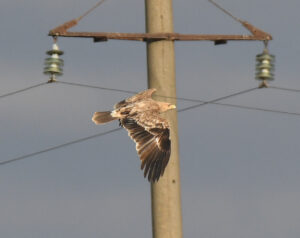Third International Scientific and Practical Conference “Eagles of the Palearctic: Study and Conservation”
Raptors Conservation. Suppl. 2. Proceedings of Conferences
Wintering Eastern Imperial Eagles in Dagestan, Russia
Dzhamirzoev G.S. (Dagestansky State Nature Reserve, Makhachkala, Russia)
Bekmansurov R.H. (Kazan Federal University, Elabuga Institute, National Park “Nizhnyaya Kama”, Elabuga, Russia)
Korepov M.V. (National Park "Sengileevskie Gory", Ulyanovsk, Russia)
Stryukov S.A. (Ulyanovsk Regional Museum, Ulyanovsk, Russia)
Ismailov H.N. (Dagestansky State Nature Reserve, Makhachkala, Russia)
Contact:
Gadzhibek Dzhamirzoev dzhamir@mail.ru
Rinur Bekmansurov rinur@yandex.ru
Mikhail Korepov korepov@list.ru
Stanislav Stryukov stanislav_str@mail.ru
Hadzhaman Ismailov dr.hadis79@yandex.ru
Recommended citation: Dzhamirzoev G.S., Bekmansurov R.H., Korepov M.V., Stryukov S.A., Ismailov H.N. Wintering Eastern Imperial Eagles in Dagestan, Russia. – Raptors Conservation. 2023. S2: 323–327. DOI: 10.19074/1814-8654-2023-2-323-327 URL: http://rrrcn.ru/en/archives/351135
Eastern Imperial Eagle (EIE;Aquila heliaca) wintering grounds in Dagestan and adjacent areas of the Chechen Republic and Stavropol Territory were monitored in February and December of 2022 as part of the project “Study and Conservation of Eastern Imperial Eagle” implemented by the Non-governmental Environmental Central “Caucasus”, Russian Bird Conservation Union (RBCU), and Nature and Biodiversity Conservation Union NABU, with the support of the NABU International Foundation and VGP Foundation.
EIE wintering grounds in Eastern Transcaucasus have been known to ornithologists for a long time (Satunin, 1907; Stanchinsky, 1914). However, the nature of the species wintering and their distribution in Dagestan remained poorly studied (Dzhamirzoev et al., 2013; Dzhamirzoev, Bukreev, 2020). During the research that was carried out in February of 2022 in plains and foothills of Dagestan, it was established that a large number of territorial EIE pairs live near their breeding territories, and EIE clusters at landfills together with other large raptors were identified. Juvenile birds were also observed on wintering, both in clusters with other raptors and in typical breeding habitats. This allowed us to assume that EIE regularly winters in Dagestan throughout the entire winter period. The wintering of these birds in the Ciscaucasia was also indicated by results we received from monitoring EIE individuals tracked in the Middle Volga region – in Ulyanovsk region and Tatarstan. In July 2022 we tagged four juvenile eagles with GPS/GSM trackers in the lower reaches of the Terek River and the vicinity of the Dagestansky Nature Reserve to find EIE migration and wintering locations in Dagestan. To confirm the regularity of wintering, additional research was carried out in December 2022 in the northern and southern plains and foothills of Dagestan (Dzhamirzoev et al., 2023; Korepov, Stryukov, 2023).
On December 8–17, 2022, 40 EIE individuals were registered in the northern part of the region and the adjacent areas of Chechnya and Stavropol. For the most part, EIE have been recorded in breeding areas, near them adult individuals possibly stay throughout the winter, as well as at food waste landfills near large settlements and in agricultural landscapes with dense populations of myomorphic rodents and clusters of pigeons (Columba sp.). Most lived alone or in pairs, less often – in small clusters at landfills. The share of juvenile birds was 17%.
At the same time, 86 EIEs were recorded on plains and foothills of central and Southern Dagestan. Here the species distribution was closely connected to breeding territories too, most adult territorial eagles stay here throughout the year. Wintering EIE gather around food waste landfills near poultry farms as well. The share of juvenile eagles among wintering EIE was 43.02% (37 individuals), but the bulk of them (n=34) concentrated near landfills. Adult eagles and nesting pairs were predominantly found on power line supports. Wintering eagles were also not recorded in half of previously known breeding territories. This is partly because our visits to EIE breeding territories were very short.
On plains in the northern part of Dagestan, the share of EIE among 12 other raptor species (n=238 individuals) in December 2022 was 17%. In terms of occurrence, EIE is second only to White-Tailed Eagle (Haliaeetus albicilla) (36%) here. Among members of the genus Aquila (n=43), the occurrence of EIE was 95% in comparison with Steppe Eagle (Aquila nipalensis) (5%).
On the plains and foothills of central and southern Dagestan, the share of EIE among 15 other raptor species (n=660) was 13.03% (n=86). In terms of occurrence, EIE is inferior to White-Tailed Eagle here too (30.76%, n=203), as well as Griffon Vulture (Gyps fulvus) (21.06%, n=139) and Cinereous Vulture (Aegypius monachus) (15,61%, n=103). Moreover, Cinereous Vulture and partly Griffon Vulture abundance is not connected to the main survey areas and are associated with registrations of migrating birds at a landfill near the village of Kakahura. Among members of the genus Aquila (n=149), the occurrence of EIE was 58% in comparison with Steppe Eagle (37%) and Golden Eagle (Aquila chrysaetos) (5%).
Of the four juvenile EIE tagged with trackers in July 2022, two spent the winter primarily in Dagestan, and two EIE died near breeding territories. Results of remote monitoring show that juvenile EIE that winter in the region roam over a larger area than adults, but nevertheless show a certain conservatism, sticking to breeding habitats and similar territories in the foothills of Dagestan and the Caspian depression.
Conclusions:
In recent years, EIE regularly wintered in Dagestan. Adult EIE typically winter in breeding territories, where they often live in pairs.
Juvenile EIE roam over a larger area than adults, but generally spend most of their time in winter in breeding habitats or similar areas.
EIE that fly from northern parts of their range to winter in Dagestan generally stick to food waste landfills (mainly from poultry farms) near settlements, as well as pasture agrocenoses with an abundance of myomorphic rodents, corvids (Corvidae), and pigeons.

